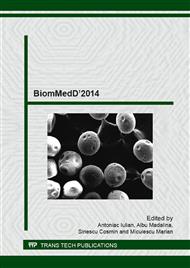[1]
B.B. Mandal, A.S. Priya, S.C. Kundu, Novel silk sericin/gelatin 3D scaffolds and 2D films: Fabrication and characterization for potential tissue engineering applications, Acta Biomater, 5 (2009), 3007-3020.
DOI: 10.1016/j.actbio.2009.03.026
Google Scholar
[2]
I.C. Stancu, A. Lungu, D. M. Dragusin, E. Vasile, C. Damian, H. Iovu, Porous Gelatin-Alginate-Polyacrylamide Scaffolds with Interpenetrating Network Structure: Synthesis and Characterization, Soft Mater, 11 (2013), 384-393.
DOI: 10.1080/1539445x.2011.642091
Google Scholar
[3]
J.F. Martucci, R.A. Ruseckaite, Biodegradable three-layer film derived from bovine gelatin. J Food Eng, 99 (2010), 377-383.
DOI: 10.1016/j.jfoodeng.2010.02.023
Google Scholar
[4]
S. Kanokpanont,S. Damrongsakkul, J. Ratanavaraporn, P. Aramwit, An innovative bi-layered wound dressing made of silk and gelatin for accelerated wound healing. Int J Pharm, 436 (2012), 141-153.
DOI: 10.1016/j.ijpharm.2012.06.046
Google Scholar
[5]
A. Saarai, V. Kasparkova, T. Sedlacek, P. Saha., On the development and characterisation of crosslinked sodium alginate/gelatine hydrogels. J Mech Behav Biomed, 18(2013), 152-166.
DOI: 10.1016/j.jmbbm.2012.11.010
Google Scholar
[6]
M. Curcio, U. Gianfranco Spizzirri, F. Iemma, F. Puoci, G. Cirillo, O.I. Parisi, N. Picci, Grafted thermo-responsive gelatin microspheres as delivery systems in triggered drug release, Eur J Pharm Biopharm, 76 (2010), 48-55.
DOI: 10.1016/j.ejpb.2010.05.008
Google Scholar
[7]
A. Serafim, I.C. Stancu, C. Tucureanu, D.G. Petre, D.M. Dragusin, A. Salageranu, S. Van Vlierberghe, P. Dubruel, One-pot synthesis of superabsorbent hybrid hydrogels based on methacrylamide gelatin and polyacrylamide. Effortless control of hydrogel properties through composition design, New J Chem, 38 (2014).
DOI: 10.1039/c4nj00161c
Google Scholar
[8]
A. Serafim, D.M. Dragusin, L.M. Butac, D.S. Vasilescu, P. Dubruel, I.C. Stancu, New hydrogels based on gelatin and acrylamide, U.P.B. Sci. Bull., Series B, 75 (2013).
Google Scholar
[9]
I.C. Stancu, D.M. Dragusin, E. Vasile, R. Trusca, I. Antoniac, D.S. Vasilescu, Porous calcium alginate-gelatin interpenetrated matrix and its biomineralization potential, J Mater Sci Mater Med, 22 (2011), 451-60.
DOI: 10.1007/s10856-011-4233-7
Google Scholar
[10]
E.S. Dragan, Design and applications of interpenetrating polymer network hydrogels. A review, Chem Eng J, 243 (2014), 572–590.
DOI: 10.1016/j.cej.2014.01.065
Google Scholar
[11]
E. Di Giuseppe, F. Funiciello, F. Corbi, G. Ranalli, G. Mojoli, Gelatins as rock analogs: A systematic study of their rheological and physical properties, Tectonophysics, 473 (2009), 391-403.
DOI: 10.1016/j.tecto.2009.03.012
Google Scholar
[12]
N.A. Peppas, P. Bures, W. Leobandung, H. Ichikawa, Hydrogels in pharmaceutical formulations, Eur J Pharm Biopharm, 50 (2000), 27-46.
Google Scholar


